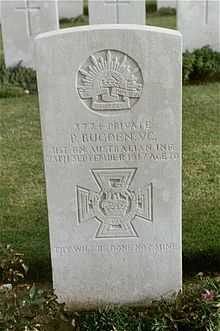Hooge Crater Commonwealth War Graves Commission Cemetery
| Hooge Crater | |
|---|---|
| Commonwealth War Graves Commission | |
 | |
| Used for those deceased 1917–1918 | |
| Established | October 1917 |
| Location |
50°50′47″N 2°56′36″E / 50.84639°N 2.94333°ECoordinates: 50°50′47″N 2°56′36″E / 50.84639°N 2.94333°E[1] near Ieper, West Flanders, Belgium |
| Designed by | Sir Edwin Lutyens |
| Total burials | 5924 |
| Unknown burials | 3578 |
| Burials by nation | |
| |
| Burials by war | |
|
World War I: 5924 | |
| Statistics source: Battlefields1418.50megs.com | |
Hooge Crater Cemetery is a Commonwealth War Graves Commission burial ground for the dead of the First World War located in the Ypres Salient in Belgium on the Western Front. Hooge is a small village on the Bellewaerde Ridge, about 4 kilometres east of Ypres in the Flemish province of West-Vlaanderen.
The cemetery grounds were assigned to the United Kingdom in perpetuity by the King of the Belgians in recognition of the sacrifices made by the British Empire in the defence and liberation of Belgium during the war.
Location

The Flanders village of Hooge was the site of a château which was used as the Divisional Headquarters for the area.[2] The staff at the château, from the 1st and 2nd Divisions were all killed when the château was shelled on 31 October 1914.[3] German forces attacked the château between 24 May and 3 June 1915, and, despite the detonation of a British mine by the 3rd Division, leaving a massive crater, took control of the château and the surrounding area on 30 July.[4] The château and the crater (craters being strategically important in relatively flat countryside) were taken by the British 6th Division on 9 August.[3] It was reclaimed by the Germans on 16 June 1916 and retaken by the British on 31 July 1917 when the 8th Division managed to push past it by about a mile.[4]
The Germans retook the site in April 1918 as part of the Spring Offensive but were expelled from the area by the British on 28 September[3] as the Offensive faltered.
During this time, the chateau was completely destroyed along with the entire village; several large craters from underground mines were blown over the course of the 1917 fighting.[5]
Foundation

The cemetery was begun in October 1917 by the 7th Division.[6] Originally containing 76 graves, the cemetery was expanded by the concentration of graves from the surrounding battlefields and from nearby smaller cemeteries.[3]
The cemetery was designed by Sir Edwin Lutyens and has an unusual feature in the stone-faced circular depression at the entrance that evokes the nearby (and now lost) craters.[7] Hooge Crater itself was filled in later in the war as the repository of hundreds of bodies and untenable. The existing water filled crater near the hotel is the result of Baron de Wynck, who landscaped three German mine craters blown in June 1916 as part of their offensive against the Canadians.
Notable graves

- Australian Private Patrick Joseph Bugden VC, who was killed on 28 September 1918 at Polygon Wood, is buried at Hooge Crater Cemetery.
References
- ↑ http://www.members.shaw.ca/lesley630/BelgiumFrame1Source1.htm
- ↑ Saturday, 22 August, 2009 Michael Duffy and Eamon Duffy (2009-08-22). "The Western Front Today – Hooge Crater". First World War.com. Retrieved 2014-04-12.
- ↑ 3.0 3.1 3.2 3.3 Reading Room Manchester. "Cemetery Details". CWGC. Retrieved 2014-04-12.
- ↑ 4.0 4.1 "Hooge Crater Cemetery". Battlefields1418.50megs.com. Retrieved 2014-04-12.
- ↑ "World War One Battlefields : Flanders: Hooge". Ww1battlefields.co.uk. Retrieved 2014-04-12.
- ↑ Saturday, 22 August, 2009 Michael Duffy and Eamon Duffy (2009-08-22). "The Western Front Today – Hooge Crater Cemetery". First World War.com. Retrieved 2014-04-12.
- ↑ http://www.diggertours.com/cems/bel/hooge.htm
External links
| Wikimedia Commons has media related to Hooge Crater Cemetery. |
-
- Cemetery register: Details
- Reports
- Plans
- Photographs. CWGC.
- Hodge Crater Cemetery at Find a Grave